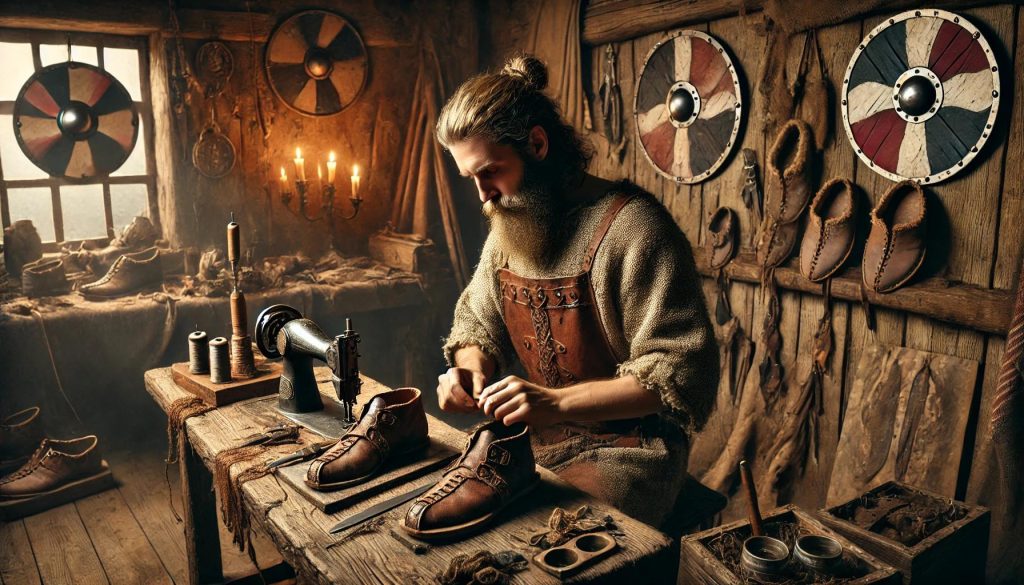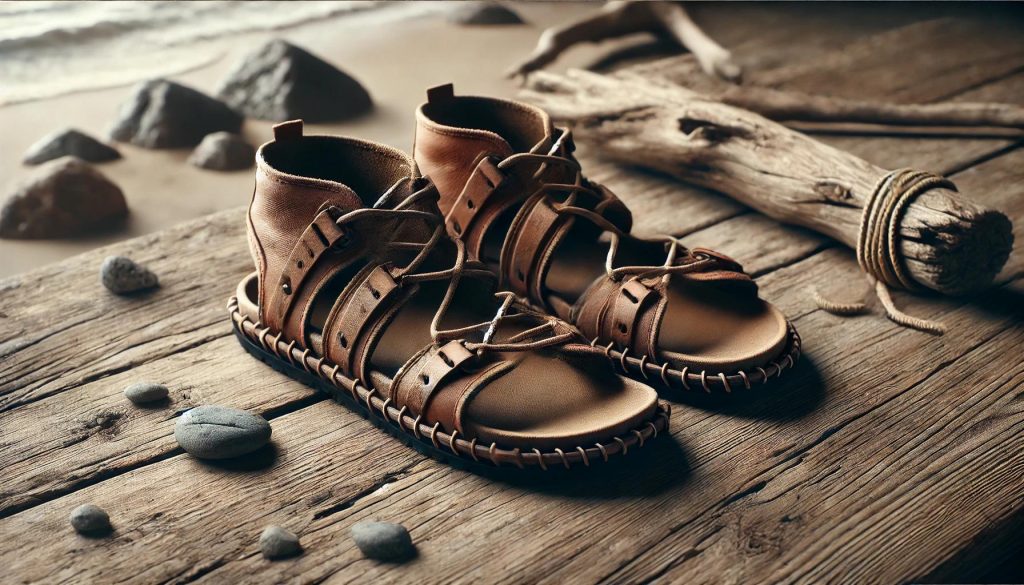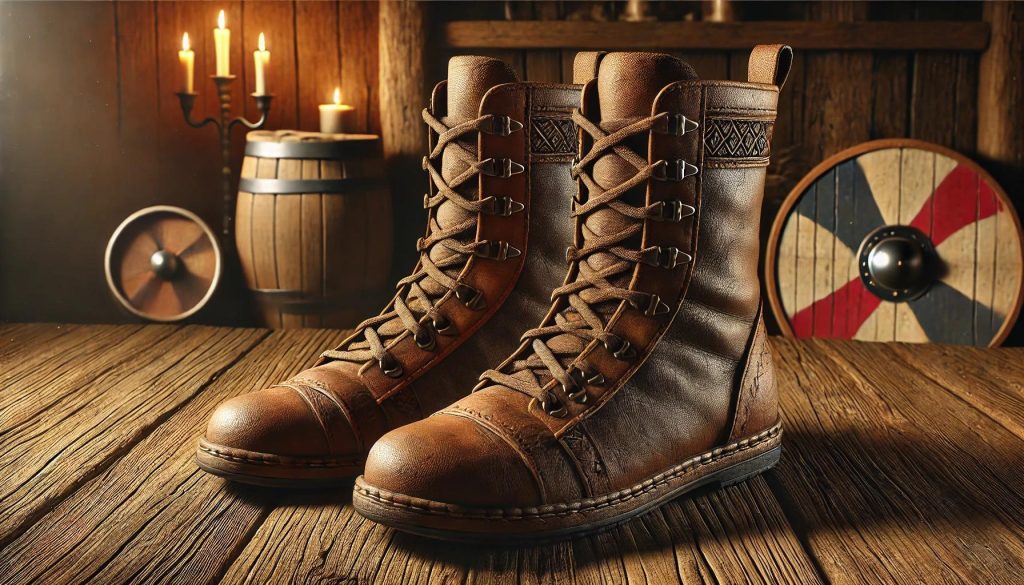Daily Life in the Viking Age, Viking Clothing and Jewelry, Vikings
What Shoes Did Vikings Wear?
The Viking Age lasted from the late 8th to the early 11th century. It was a time of exploration, trade, and cultural exchange. We will look at what shoes Vikings wore, both for men and women.
These shoes were not just for walking. They showed the skill and culture of the Scandinavian people through their leather shoes.
This article will cover Viking footwear. We will discuss the materials, construction, and types of shoes and see how they fit into Viking society.
Learning about Viking shoes helps us understand their daily lives. It also shows how their style has influenced today’s fashion.
Introduction to Viking Footwear
Viking footwear tells us a lot about their culture and daily life. Historical Viking shoes were not just for looks. They protected, kept warm, and helped people move around on different terrains and in various weather.
So, what kind of shoes did Vikings wear? They made their shoes from the materials they had around them. The shoes changed based on what they needed to do, like farming, sailing, or fighting. This shows how well they adapted to their world.
During the Viking age, their shoes showed what their lifestyle was like. They had everything from simple sandals to solid boots. These shoes helped them move through tough places and weather. The focus on making shoes work well shows how much they were a part of their daily lives and how Viking women interacted with others.
What Shoes Did Vikings Wear?
Vikings had special shoes for their daily lives. They needed shoes for farming, sailing, and more. Their shoes showed their cleverness and how they adapted to different places.
Everyday Use of Viking Shoes
Vikings used many types of shoes for daily tasks. Sturdy leather boots were especially popular because they were comfortable and strong. These boots were great for farming, hunting, and sailing.
They also wore sandals in warm weather. These were simple but effective for hot days.
Special Purpose Footwear
Vikings had special shoes for special occasions. Warriors wore strong boots for battle, which provided extra protection.
Ceremonial shoes showed status and were worn at important events. This indicates that the Vikings knew how to choose the right shoes for each situation.
Materials Used in Viking Shoes
Historical Viking shoes were made with durable and comfortable materials, which show the Vikings’ practical and resourceful nature.
Primary Materials: Leather and Wool
So, what were Viking shoes made out of? Leather and wool were the primary materials for Viking shoes. The main part was leather, mostly from cattle. Artisans made it strong and weatherproof.
They used animal fats and beeswax to protect the leather, which made the shoes last longer and kept out water.
Wool was used for insoles and linings. It kept feet warm in cold weather. This was important for Vikings living in harsh climates.
Functional Treatments
How materials were treated was key to the function of Viking shoes. Leather treatments prepared the boots for the elements, and natural waterproofing helped Vikings walk in wet places.
Wool made the shoes soft and breathable. This was good for wearing them for a long time.
The choice and treatment of materials show Viking craftsmanship’s ingenuity. Like their tunics and cloaks, Viking shoes were made to meet the needs of their environment and lifestyle.
Construction Techniques of Viking Shoes
Viking shoes were made with care and creativity. They used a single piece of leather for better durability and to keep water out. This made the shoes last longer and work better in wet conditions.

Using one piece of leather required less stitching, which made the leather shoes faster and stronger. Let’s look at how Viking shoes were made.
Single Piece Leather Design
The single piece of leather was a smart choice. It reduced weak spots and made the shoes water-resistant. The Vikings made the shoes in one piece for a better fit.
This design was great for long walks and hard work. It made the shoes comfortable for many foot types.
Stitching and Fastening Methods
Stitching was vital in making Viking shoes. Whipstitching and lacing were used for different reasons. Whipstitching strengthened seams, and lacing improved shoe fit.
Fastening was also important. Toggles and leather straps kept the shoes on tight. These smart ways of making shoes helped Vikings use them for many things.
Types of Viking Shoes
The Viking era had many types of shoes for different needs. These shoes tell us about daily life, culture, and the climate of Scandinavia. We’ll look at sandals, boots, high-top shoes, and how Vikings chose shoes for each season.
Sandals
Sandals were simple and made for warm weather. They were made from leather or plants for breathability. They had a flat sole and straps to keep them on.
They were great for everyday tasks and fun activities. This made them a favorite among Vikings.
Boots and High-top Shoes
Boots and high-top shoes were strong and protective. They were made from thick leather for durability. They were good for land and sea adventures.
Their tall design kept calves dry and safe from debris. They were made with strong stitching and closures for support.
Footwear for Different Seasons
Viking shoes changed with the seasons. In cold months, they used thicker materials for warmth. Men and women had unique styles, with some having fur lining or waterproofing.
Like those of Viking women, seasonal shoes showcased Viking style and culture. They were not just for function but also fashion.
What Did Viking Shoes Look Like?
Viking shoes tell us about their culture and society. Their design and decorations can teach us a lot. These historical shoes show us what life was like back then.
Design Features
Viking shoes were simple but useful. They came in different styles, from sandals to boots. Here are some common features:
- Single-piece leather constructions that offered durability.
- Stitching techniques that enhanced both aesthetics and functionality.
- Angled toe shapes contributed to a distinct Nordic silhouette.
These features made the shoes practical for Viking life. They were made for everyday use.
Color and Decoration
Colors and decorations showed a Viking’s style and status. They used natural dyes for colors like browns, reds, and blacks. Decorations included:
- Engraved symbols and patterns that held cultural significance.
- Horizontal or diagonal brooches are used as embellishments.
- In some instances, colorful threads are interwoven into the designs.
These decorations showed a Viking’s fashion sense and identity. They made Viking shoes more than just footwear. They were a part of their culture and society.
Viking Footwear in Historical Context
Looking into Viking footwear means studying important finds from the past. These discoveries show us how Vikings made their shoes and what they were made of. They also tell us about the role of shoes in Viking culture.
Archaeological Finds
Archaeologists have found many Viking shoes across Europe. In York, for example, they found shoes in different styles, which changed based on where the Vikings lived and what they did.
Insights from the Oseberg Ship
The Oseberg ship is a key find that tells us much about Viking shoes. Shoes found in the ship’s burial site show how Vikings used them. They were for special events or everyday life.
The ship’s finds also show the skill of Viking craftsmen. They tell us about the shoes’ connection to social status, which helps us better understand Viking culture.
Viking Shoes Across Scandinavia
Viking shoes across Scandinavia showed different styles. These styles reflected the varied cultures in the region, including the trousers worn by Viking men. The local materials and climate shaped the designs.
Each community had its own shoe needs. This led to many different types of shoes.
Regional Variations

Every Scandinavian region has its own shoe style. This was because of the environment and what was available.
- Coastal areas had lighter sandals for comfort on boats and at markets.
- Inland areas had colder climates. So, they made insulated boots to keep warm.
- Places with lots of sheep used wool linings in their shoes.
This shows how Viking shoes varied across Scandinavia and how communities adapted them to local needs.
Influences from Other Cultures
Cultural exchanges shaped Viking footwear. Trade routes brought new ideas and materials for viking clothes and footwear. This led to:
- Mediterranean designs and stitching techniques were adopted.
- New materials from trade partners made Viking shoes look and function better.
- Styles from Slavic and Anglo-Saxon peoples were also seen.
These exchanges made Viking material culture dynamic. They showed how different cultures blended.
Societal Aspects of Viking Footwear
Viking footwear was more than just for walking. It showed a person’s social status, job, and where they belonged in the community. Shoes were a big part of Viking society, revealing who was who.
The Role of Footwear in Viking Society
Footwear in Viking culture was not just for protection. It showed a person’s status and duties. Wealthy people wore fancy shoes, while the poor had simpler ones. This made shoes very important in Viking life, showing who was in charge.
Footwear and Gender Differentiation
Men and women wore different shoes in Viking times. Men needed strong shoes for work and war, while women wore elegant shoes for home duties. This shows how shoes reflected Viking culture and roles for men and women.
Care and Maintenance of Viking Shoes
Keeping Viking shoes in good shape helps them last longer and look better. Using old-fashioned care methods shows respect for their craftsmanship. This section discusses how to clean and store Viking shoes properly.
Cleaning Practices
Cleaning Viking shoes often is key, especially if they’re made of leather. Dust and dirt can harm the material. Here are some cleaning tips:
- Gently brush off dirt with a soft-bristled brush.
- Use a damp cloth to wipe down the surfaces.
- Condition the leather with natural oils to prevent it from cracking.
- Don’t let them get too wet, which can damage the material.
By following these steps, Viking shoes will stay in great condition for many years.
Storage Solutions
Storing Viking shoes right is also very important. The right place can stop them from getting damaged. Here are some storage tips:
- Store them in a cool, dry spot away from sunlight.
- Use shoe trees or paper to keep their shape.
- Don’t put them in tight or too humid places.
Using these storage methods helps Viking shoes keep their shape and stay in good condition.
Modern Relevance of Viking Footwear
Viking footwear is now part of today’s fashion. Designers mix old Viking styles with new trends in Viking clothes, creating old and new shoes.
Contemporary Viking-inspired Designs
Today, Viking-inspired shoes are all the rage. They use strong leather, detailed stitching, and natural colors in their Viking-age footwear. These shoes are not just for history buffs. They’re for anyone who wants to stand out with their style.
Influence on Modern Fashion
Viking shoes have greatly influenced modern fashion. They inspire new shapes and materials. You can find everything from casual to formal shoes with a Viking twist.
Conclusion
Viking footwear is more than just shoes. It shows us how Vikings lived and what their society was like. The way they made shoes tells us about their daily lives and their culture.
The shoes were made with care and showed off the Vikings’ skills in crafting Viking-age footwear. They were both useful and beautiful, which shows how vital shoes were in Viking times.
Viking shoes also tell us about the Vikings’ values. They were not just for protection. They showed who a person was and where they came from. Today, we can see how Viking shoes still influence our fashion.
This shows us how Viking footwear is special. It connects us to the past and shows us the lasting impact of Viking craftsmanship. It’s a reminder of the beauty and importance of their shoes.

